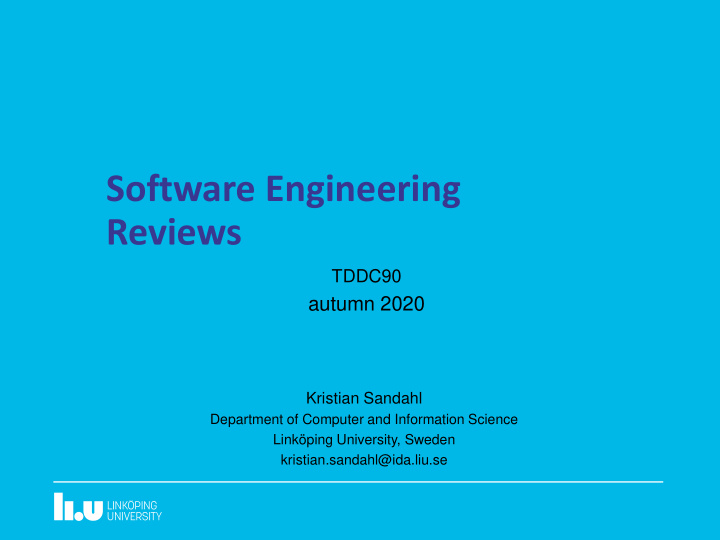



Software Engineering Reviews TDDC90 autumn 2020 Kristian Sandahl Department of Computer and Information Science Linköping University, Sweden kristian.sandahl@ida.liu.se
Agenda - Theory 2 Part II Part I Inspections Other reviews Part II Variants and research
3 Part 1 Inspections
Systematic inspections 4 The best way of finding many defec ts in code and other documents ▪ Experimentally grounded in replicated studies Goals: Find defects (anomalies) Training Communications Hostage taking
5 Development over the years • Fagan publishes results from code and design inspections 1976 in IBM systems journal • Basili and Selby show the advantage of inspections compared to testing in a tech-report 1985. • Graham and Gilb publish the book Software inspections 1993. This describes the standard process of today. • Presentation of the Porter-Votta experiment in Sorrento 1994 starts a boom for replications. • Sauer et al compare experimental data with behavioural research in a tech-report 1996 • IEEE std 1028 updated 2008
6 Roles • Author • Moderator (aka Inspection leader) • Reader (if not handled by the Moderator) • Inspector • Scribe (aka Recorder)
7 Process • Initial: • Group: • Check criteria • Detection, or • Plan • Collection • Overview • Inspection record • Data collection • Individual: • Exit: • Preparation, or • Detection • Change • Follow-up • Document & data handling
8 Inspection record • Identification • Location • Description • Decision for entire document: • Pass with changes • Reinspect
9 Data collection • Number of defects • Classes of defects • Severity • Number of inspectors • Number of hours individually and in meeting • Defects per inspector • Defect detection ratio: • Time • Total defects
Our inspection record 10 Id Loc. Description Class. 1 2 3 4 5 6 7 8
11 Practical investigation • 214 code inspections from 4 projects at Ericcson • Median number of defects = 8 • 90 percentile = 30 • Majority values: • up to 3.5 h preparation per document • up to 3 h inspection time • up to 4000 lines of code • 2 to 6 people involved Inspection rate (IEEE Std 1028-2008) Requirements or Architecture (2-3 pages per hour) Source code (100-200 lines per hour)
12 Regression wrt defect detection ratio • Preparation time per code line typically 0.005 hours per line (12 minutes per page) • Size of document have negative effect on DFR, max recommendation 5000 lines • A certain project is better than two of the others • 4 inspectors seems best (not significant) • Analysis performed by Henrik Berg, LiTH-MAT-Ex-1999-08
13 Part II Other reviews
14 Other reviews • Management review – check progress • Walk-through – improve product, training • Technical review – evaluate conformance • Audit – 3 rd party, independent evaluation • (Peer) Review • Buddy-check • Desk check
K Sandahl/reviews 2020-09-29 15 Technical reviews • Determine the technical status of the product • Evaluate conformance to specifications and standards • Evaluate if the software is complete and suitable for intended use • Performed by technical leadership and peers for a decision maker • Higher volume of material than inspections • Output: corrective actions (date and responsible), status, recommendations
K Sandahl/reviews 2020-09-29 16 Audits • External 3rd party (independent) evaluation of conformance to specification and standards • An initiator (manager, customer, user representative) decides on the need for an audit • Evidence collection, investigative actions • The audit team gets information form liaison within the audited organization • Output: Findings (major, minor)
Root-cause analysis 17 Main • Performed regularly for severe defects, cause frequent defects, or random defects • Popular mind map: The Ishikawa diagram Main Main • Parameters: cause cause • Defect category • Visible consequences • Did-detect Problem • Introduced • Should-detect Main Main Main • Reason cause cause cause
18 Tool-based code review in Gerrit Sometimes the term ” inspection ” is Source: used for this review. https://review.openstack.org/D ocumentation/intro-quick.html
19 Part II Variants and research
Reading techniques - checklist 20 defect attention area • Checklist • Industry standard • Shall be updated
Reading techniques - scenario 21 • Scenario, e.g. • Algorithm • Data types • Missing functions • Vulnerabiltiy • A checklist splitted to different responsibilities • 30% higher DFR ?
22 Reading techniques – perspective-based • Different inspectors repre- sent different roles, e.g. • Programmer • Tester • Architect • Real or played roles • 30% higher DFR ?
23 Cost of quality • Person-hours • Calender time • Good reading techniques • Good data recording
”Optimal” method 24 Inspectors Repository Two experts Defect list False positives
25 Summary - What have we learned today? • Inspections rule! • Inspections are expensive
That’s all, folks!
Recommend
More recommend